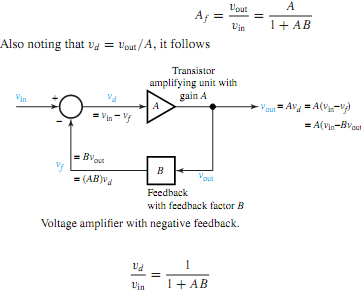Q. Amplifiers with Feedback?
Almost all practical amplifier circuits include some form of negative feedback. The advantages gained with feedback may include the following:
• Less sensitivity to transistor parameter variations.
• Improved linearity of the output signal by reducing the effect of nonlinear distortion.
• Better low- and high-frequency response.
• Reduction of input or output loading effects.
The gain is willingly sacrificed in exchange for the benefits of negative feedback. Compensating networks are often employed to ensure stability.Avoltage amplifierwith negative feedback is shown by the generalized block diagram in Figure. The negative feedback creates a self - correcting amplification system that compensates for the shortcomings of the amplifying unit.
The gain with feedback can be seen to be

The product AB is known as the loop gain because vf = B(Avd ) = (AB)vd . In order to obtain negative feedback, the loop gain must be positive. With AB > 0 in Equation it follows that |Af | < |A|. Thus, a negative feedback amplifier has always less gain than the amplifying unit itself. With AB >> 1, Af remains essentially constant, thereby reducing the effect of transistor parameter variations in the amplifying unit. If the feedback unit has |B| < 1, one can still obtain useful amplification since |Af | = 1/|B| > 1.
These are also known as RC amplifiers since their circuits need only resistors and capacitors. There are of course other transistor amplifiers that do not have the small-signal limitation and are also not limited to the use of resistors and capacitors in their circuits. For larger input signals the linear dependence of the current on the signal level may not be maintained.